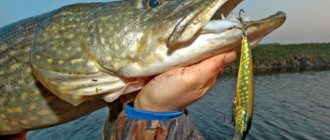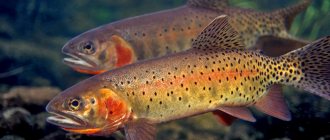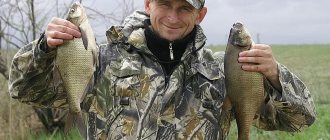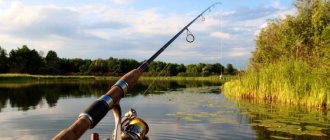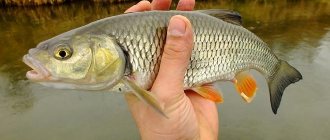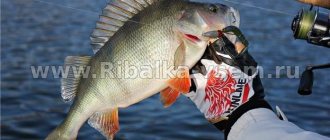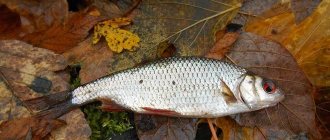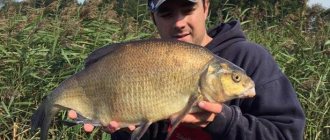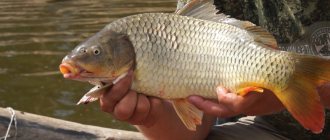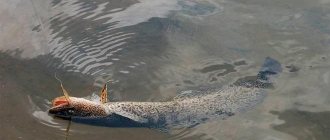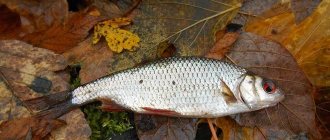Equipment for bleak
Every year, more and more anglers are becoming more interested in catching spring bleak, especially large ones.
This fish is lively, active and tasty. Spring interest in it is due to two factors: the ban on spinning fishing and the ease of finding large pre-spawning concentrations of fish. Some people think that the ease of fishing is also attractive, but I don’t agree with this. The tackle is not as basic as it might seem to be. Most anglers limit themselves to one or two fishing trips, believing that the bite is over because the fish have left. And the reason is not the lack of fish, but the inability of the fisherman. Actually, fishing during the period when fish bite at everything and you can catch them unlimitedly is not of interest. This is not fishing, but primitive prey. It’s good that it ends quickly, and it’s not possible to “catch” this period every year.
For me, interest in bleak is maintained by the spring mood in anticipation of tench and carp starting to bite, as well as the technical complexity of high-speed fishing, when the glutton is over, there are a lot of fish but they are capricious.
When the bleak stops throwing itself at everything that falls into the water, the angler with rough gear not suitable for fishing becomes disappointed and begins to catch (or tries to catch) bream, crucian carp, any fish that is not very afraid of a thick fishing line with a float buoy and a well-fed crawl on a carp hook, the main thing in guaranteed, predictable, one might say, controlled and effective bleak fishing is the tackle, or rather, the equipment.
Components of bleaching equipment
Equipment for a float fishing rod is a structure consisting of a hook, fishing line, sinkers, float and additional elements, if any.
Bleak responds best to bait that naturally sinks at a low speed after falling to the surface of the water. In order for the nozzle to fall slowly, a sinker is required, which contributes to the low speed of the fall of the equipment. A small sinker holds a small-capacity float in the water column.
However, with a too small float with a load capacity of less than 0.2-0.3 g, the entire equipment becomes so light that not every rod can handle it. Casting too light a tackle is difficult not only with a long rod, but also in windy weather. Depending on the quality and length of the fishing rod, the depth of descent, weather conditions, current and activity of the fish, equipment with floats with a carrying capacity of 0.15-1 g is selected. There is no point in using heavier equipment, except for cases when you want to catch bleak not with a flywheel, but for example, tackle for long casting.
When the water is very rough, you can make fishing much easier by placing an additional sinker between the tip of the rod and the float, which sinks the line, and the drift speed of the equipment sharply decreases. The sinker needs to be attached closer to the rod so that it does not overload the float and flood almost the entire line. The mass of the sinker and the distance to it are selected experimentally on each fishing trip.
An important role is played by the design of the float, which should signal a bite from the moment the bait falls on the water until it drops to a given depth, as well as all touches of the bleak to the bait, hovering or drifting in the water column.
In the spring, bleak in most cases is caught from above and very rarely from a depth of 1-2 m, so the descent is 20-50 cm, regardless of the depth of the reservoir at the fishing site. The float must be stable, that is, maintain a vertical position regardless of the roughness on the surface of the water. Bleak reacts well to moving bait, therefore, if there are no bites, it is worth tugging or dragging the equipment, and in order for bites to be visible during any manipulation with the equipment, a float that is stable when retrieving is required. It must have a heavy keel: long - gives maximum stability to the float, but a short and massive (thick) keel is preferable. A float with a long keel is relatively slow to accept the first bite. Floats with a long keel and a small carrying capacity are more suitable for catching perch, roach and crucian carp in the bottom layers of water. The sensitivity of the float has a significant impact on the sensitivity, and you need to choose floats with the lightest possible coating (minimum paint and varnish). Most of the equipment's mass should be concentrated in the load. Since the fishing line is thin and the equipment is light, the smallest shot weights are used. It is important that the line passes through the sinker exactly along the axis, which significantly reduces the number of overlaps during fishing.
The quality of the sinker depends on the hardness of the lead and the shape of the cut; a good sinker is easily clamped on the fishing line with your fingers and just as easily released with your fingernail. A clamped sinker does not spontaneously move along the line during fishing, but with some tension it can be moved. By the way, while moving the sinkers, it’s also worth checking how well the fishing line is calibrated. Hooks require special attention. An experienced angler always chooses a hook that matches the shape and size of the bait, as well as taking into account the size and activity of the fish. For catching bleak, I recommend single-bend hooks with a spatula, a straight bend and an elongated shank with a small beard. It is important that the hook has a sharp and strong sting, because one hook can catch several hundred fish. It is worth paying attention to the hooks of the Owner 63157 Straw series. On the underside of such a hook, a maggot sits firmly and can withstand dozens of bites. In addition, this hook is convenient to remove from the fish’s mouth, which is important during very active biting. When the bleak takes the bait carefully, I use Malch tournament hooks, and if there are no such hooks. then from the Owner 50145 kisu-k series (any color). A hook that is correctly selected according to the size of the bait significantly increases the number of bites. To attach maggots, it is preferable to use hooks No. 16-20, and for bloodworms - No. 18-22.
Tackle and fishing methods
To ensure year-round bleak fishing, you need to stock up on a variety of gear. Accordingly, fishing tactics and techniques change.
Float rod
The most popular fishing rod for bleak is the float rod. It is caught throughout the open water season, starting in April, when the spring sun has just warmed up the top layer of water. During the year, the equipment is slightly changed in accordance with fishing conditions.
A float for catching bleak is most often built on the basis of the lightest fly rod 3-4 meters long. It is equipped with a monofilament line 0.08-0.12 millimeters thick. Coarser tackle should be used if there is a chance of catching crucian carp, roach, bream or other larger fish in the bycatch. By the way, when catching our silver beauty, you need to be prepared for such consequences.
Advice! On the river, it is better to use a Bolognese fishing rod, which is more adapted to fishing conditions in the current.
A light float is placed on the fishing line, the carrying capacity of which usually does not exceed three grams. Here they follow the rule that weight depends on the strength of the current, so in a stagnant body of water only one gram is enough.
Sticky floats have a spindle-shaped shape and a long keel for better stabilization in the water flow.
The float is loaded with several pellets, and their position is changed depending on the temperature of the water and where the fish are located. In spring and autumn, when the bait is deep enough, the weights are moved lower to the undergroove so that the hook with bait reaches the desired horizon faster.
In the summer, in warm water, schools of fish stand below the surface of the water, so the pellets are distributed evenly from the feeder to the float so that the bait sinks as slowly as possible.
The smallest hooks are used; depending on the bait, they can be from 18 to 24 numbers according to the international classification. You can often notice that on the gear of athletes or simply experienced fishermen, the hooks do not have barbs.
Barbless hooks allow for high-speed fishing and significantly save time on removing fish.
Fishing with a float rod begins with a test feeding of the place. Throw several small balls of bait into the water and watch the behavior of the fish. The bleak gathered for a treat will give itself away.
Equipment design
Having selected all the elements of the glued equipment, you need to assemble it. To do this, the fishing rod is laid out to its full length, a loop is made on the fishing line and secured to the tip of the fishing rod. The fishing line is measured so that its length is 30-50 cm less than the length of the fishing rod. If the casting distance is not enough, you should take a longer rod and longer equipment. The shorter the line, the more convenient and efficient it is to cast, manage equipment and realize bites.
In the design of equipment for gluing, one feature must be taken into account. It is very rare to come across bleak weighing 70-80 g, so for very light equipment, it would seem that the thinnest fishing lines could be used. However, practice has shown that in the spring it is better to take a fishing line no thinner than 0.09 mm. Firstly, a fishing line that is too thin inevitably breaks off along with the hook when you are in a hurry to remove the fish. Secondly, the thinner the line, the more often it gets tangled and tangled. On the other hand, the thinner the line, the less sailing the equipment is and the easier it is to control. A compromise was found in a special adhesive design. The leash is made from a fishing line thicker than the main one.
Some tips on bleak fishing techniques
You need to know how to use any of the right gear. Firstly, I advise you to forget about the usual casting from under the hand or from the side. The cast needs to be sharp, from behind the back, which is why a shortened fishing line is needed. The equipment should lie on the surface of the water in a straightened state along its entire length. Then equipment overlaps and inaccurate casts are eliminated. During casting, all flaws in the gear are revealed. It often happens that the equipment does not fly. Apart from weather disturbances such as wind or heavy rain, there are two reasons: the first is that the chosen rod is bulky and not suitable for casting light structures, the second is related to the first - the equipment is too light for the given fishing conditions. Heavier equipment will be needed if you increase the thickness of the fishing line or when you have to fish with a large descent in the current.
Finally, the first cast is made. But don’t rush to immerse yourself in contemplation of the float against the backdrop of the landscape. Without waiting for the float to take a vertical position, quickly recast, or even better, several sharp, quick blows with the equipment on the water in the bait area. Bleak instantly reacts to the fall of any object into the water and is interested in what has fallen. After several such hits of the rig on the water that attract fish, throw it and wait until the float sinks to the antenna. If there are no bites within two to eight seconds, rethrow the rig 10-20 cm to the right or left. If this does not cause a bite, quickly change the descent. It is impossible to predict whether it needs to be increased or decreased; it must be felt. Actually, the whole technique for catching bleak comes down to re-casting the equipment as quickly and accurately as possible, throwing in small portions of bait, and changing the descent.
After several greedy bites, the bleak begins to try and throw the bait. On equipment weighing about 0.2-0.4 g, such touches of the fish to the bait are clearly visible. To get the fish to bite, you need to do the wiring. That is, after casting the rig, as soon as the float takes a vertical position, you need to move the rig with the rod in one direction or another. The wiring speed is selected in each specific case. Often, instead of uniform, wiring with short twitches of the equipment helps. Fall wiring is very effective. When the rig touches the surface of the water, you should immediately drag it very slowly to the side, while the speed at which the bait falls decreases. The slightest touch of the fish on the falling bait becomes visible at any stage if the line is constantly stretched.
Catching bleak
Bleak is perhaps one of the most common fish in our country and, of course, catching bleak in childhood is also very popular among young anglers.
Most fishermen who have become mature and experienced began their fishing careers by catching bleak - this small fish. Having matured a little, we fishermen begin to somehow sharply hate it because it is too small, very numerous and incredibly voracious. It often happens that larger fish simply do not have time to feast on our bait, since the bleak manages to bite everything, if not eat it, then take a fair bite before it arrives.
In different regions of our country, bleak is called differently. Sebel, top melter, silyavka are just a few of her nicknames. Rarely does it reach its trophy size - 30 cm. Usually, the catches are dominated by individuals measuring from 10 to 15 cm. Less often - twenty centimeters.
What to catch bleak with
Bleak is not very picky in choosing food and can be caught with almost anything. But I rarely use vegetable baits such as bread, dough, mastyrka, and so on. The fish's mouth is too small, and it will most likely simply pick off your bait before you hook it and pull it ashore.
In principle, you can roll up very microscopic balls from the above baits and try to fish with them, but, believe me, you will get tired of such fishing very quickly, since you will have to hook the bait during intense biting, every few seconds.
A worm or bloodworm is also not the best choice when catching bleak. Their skin is too delicate, and the fish will simply tear them off the hook little by little, mocking you and forcing you to make empty hooks until it completely pulls you off the hook.
I prefer and advise everyone to catch bleak using maggots, and of course semolina. It has a very strong skin that can withstand more than one bite, it lives in water for a long time and is small in size - in short, it is ideal for catching bleak.
Catching bleak on a float rod
Bleak (lat. Alburnus alburnus) is a fish from the carp family (Cyprinidae). In different regions of Russia, this fish is called differently: in the Vyatka province - “shekleya”, in the Vologda region - “verkhovodka” or even “baskleyka”.
Bleak is a small dark grayish fish with a greenish tint, 10-20 cm in size and weighing up to 60 grams, although larger individuals are also found. The bleak's favorite treat is maggots. It is caught using a float rod, which you can make yourself or buy in a specialized store.
Light float rod device
A rod, fishing line, float, sinker, leash and hooks - this is what a float rod with a blind rig consists of.
Rod
The rod should be strong, long, light, elastic and flexible. The ideal length of a regular fly fishing rod for bleak is 4 m. It is very light and allows you to make casts without wasting any power energy. But when fishing at long ranges, for example, if a large coastal part of your reservoir is covered with grass, choose fishing rods up to 6 meters, but no more, otherwise it will become completely uncomfortable.
The material from which the fishing rod is made is carbon fiber, fiberglass or composite. The lightest and most elastic fishing rods are made of carbon fiber (carbon). It is worth remembering only one of their features - you cannot fish with them in a thunderstorm.
Equipment
Equipment is the main component of successful float fishing. Read more about the correct float equipment, and here we will briefly touch on the nuances of the float equipment.
- Fishing line. For catching bleak, we recommend a leash line of up to 0.12 mm, and a main line of 0.16 – 0.18 mm. But a light rig with a thick fishing line cannot be cast far.
- Float. When fishing for bleak, the float should be thin, easily sink into the water when bitten, its upper part should be painted black, yellow, white, pink, or with colored varnish or luminous paint.
- Leash. The leash makes the tackle itself less noticeable for bleaking. The leash is thinner than the main line. When catching bleak, use leashes 0.06-0.08 mm long up to 20 cm.
- Sinkers. When catching bleak, it is advisable to use small pellets strung one after another at a distance of 2-3 mm from each other.
- hooks No. 2.5 according to domestic numbering, so that the bait easily fits into the mouth of a small fish. According to the import classification, hooks No. 16-22 are suitable.
Loading
The float can be loaded both on the pond and at the time of setting up the equipment at home using a plastic bottle, jar or in the bathtub. The correct loading is at the very beginning of the top of the float. When biting, the fish should not notice strong resistance and the float should quickly sink. Only with such a load is it possible to impart high sensitivity to the entire gear.
Description of spring fishing
Using a float rod with the right equipment and bait, you can catch more than a dozen of these fish and get real pleasure.
And although bleak bites excellently at any time of the year, catching it in the spring is especially interesting, so you can start fishing immediately after the ice melts . For successful fishing, it is important to take into account some characteristics and individual preferences of fish at different times. The right approach to fishing and following the recommendations of experienced fishermen is the key to a good bite anywhere and at any time.
When choosing tackle for bleak in the spring, it is customary to use a traditional float fishing rod with a blind rig and up to 5 meters in length. As for the diameter of the fishing line, it should be from 0.1 to 0.12 mm. In this case, you can comfortably lower the nozzle into the water and not worry about frequent knots or overlaps.
And to minimize them, you can use the method of distributing pellets along the working descent. One of two options is used as a bite indicator (float). The first should be keelless (also called “needle”) - suitable for fishing near the surface of the upper layer, and the second keeled - if fishing occurs at a depth of 70 centimeters.
Selection and installation of gear
To properly assemble and configure a float rod, you need to take into account some nuances. The tackle has a simple design, so even a beginner can assemble it in a few minutes.
The only point that needs to be given special attention is the shape of the float. Experts recommend giving preference to drop-shaped floats in the form of a stick , or thin elongated products. With their help, you will be able to detect even the slightest bite of a river herring, and the fish will not be afraid of a float floating past.
Also, such floats should have a minimum load capacity, but if you fish in strong currents, you need to use weighted versions.
To catch bleak, use plug and fly tackle . It’s good if you have two tools at your disposal, because each of them is suitable for specific situations. For example, fly rods are much lighter than plug rods, so they are easier to hook and get fish out of the water during intense biting.
In turn, the plugs are relatively heavy, which makes them useful for working in strong currents and winds.
Lure
The bait should attract fish: taste and smell, due to which it remains in place for a long time.
There are several ways to feed bleak. Let's look at them in order.
- Making splashes of water. You can simply scoop water into your hand and drop it onto the float. Splashes and splashes attract bleak.
- Creating turbidity around the float. Take clay or soil from the shore and leave it to the float. Bleak loves mud, it looks for bait in it. This is where you offer your hook and bait.
- Feeding with surface solid and crumbly food. More on this later.
Recipe for crumbly fine groundbait:
- For bait you will need bran and crackers, preferably bread crumbs.
- Grind them and mix 1:1. It is good to add a flavor with a light fruity smell to the fertilizer: strawberry, pear, vanilla or dill oil.
- Before starting fishing, add a little water to this mixture, mix everything thoroughly, now it is easy to throw it at the fishing point, it will sink very slowly and attract surface bleak.
In cold water, you can add bloodworms to the bait and catch them with it.
A simple crust of bread can act as a purely superficial solid bait. The main thing is not to throw in too large a piece; a piece the size of a chicken egg is enough. The fact is that the fish eat it for a very long time, and if the piece is too large, it will begin to turn sour in the water, which will have a bad effect on the environment.
About how to fish with a bombard - spinning equipment for catching white fish with artificial and animal baits. Catching large bleak at a great distance from the shore.
Float rod
Considering the small size and weight of the bleak, the float tackle should be as light and elastic as possible. When choosing a fishing rod, you should give preference to models with a fast action. The blank material can be any, but for greater convenience it is better to use carbon fiber rods.
The length of the rod is selected depending on the fishing conditions and time of year. In spring and summer, when the fish prefers to stay near the shore, a 2.5-3.5 m rod is suitable. In autumn, the best option would be a blank with a length of 4 m or more.
To catch bleak, blind equipment is used, so the reel for a float rod does not play a special role, and can be anything, as long as it copes with the task of winding the fishing line.
For the main line, monofilament with a cross-section of 0.08-0.1 mm is used, for the leash - 0.06-0.08 mm. The length of the leash should be 15-30 cm.
The float for bleak should not be large and heavy. Sometimes even fishermen use floats for winter fishing rods with a load of about 0.1 g. For long-distance fishing, you can use heavier models with a load capacity of up to 1 g. As for the shape of the bite indicator, “needles” and teardrop-shaped models have gained the most popularity.
The load is selected under the float, and when diving, only its antenna should remain above the water. It is better to use a set weight - this will help the tackle sink to the bottom more slowly and give the bleak more time to grab the bait.
The size of the hook for bleak will depend on the type and size of the bait:
- small maggot – No. 24-No. 22 (with a long white shank);
- fly - No. 20-No. 22 (with a long forearm of blue or black);
- bread, dough, semolina - No. 20-No. 17 (with a short forearm of white or yellow);
- apple, nut or mealworm - No. 20-No. 18 (with a long yellow shank);
- small worm – No. 18-No. 17 (black);
When catching bleak on a float rod, both plant and animal baits are used. Taking into account the fact that this fish can change its culinary preferences, it is better to have several types of bait of different types with you.
The most popular baits for catching bleak on float tackle are:
- maggot;
- bloodworm;
- various worms (small);
- semolina;
- dough;
- bread (white);
- insects (flies, midges);
The technique for catching bleak with a float rod does not involve any special techniques and consists of casting the tackle, observing the behavior of the float, and hooking the fish when it bites.
Before starting fishing, it is recommended to feed the area. It is important that the bait begins to dissolve immediately when it gets into the water. It is better, of course, to use purchased mixtures designed specifically for bleaking, such as Traper Explosive. These baits create a thick cloud of tiny particles of the mixture, and in addition contain flour from silkworm larvae, the taste of which drives the bleak crazy. If you cannot find such bait, you can use mixtures for roaches, or prepare it yourself.
The simplest bait for bleak can consist of only two components: breadcrumbs, which are the basis for most mixtures, and rye bran. All this is ground in a coffee grinder to a powdery state. The bait is mixed already at the fishing site using water from the reservoir where fishing takes place. You should also think about flavorings. Bleak loves the smells of vanilla, honey and strawberries, and also responds well to the factory-made tutti-frutti flavoring. They are added to the already prepared soaked mixture. You can prepare more complex baits from the following ingredients:
- bread crumbs - 3 parts;
- powdered milk – 2 parts;
- semolina – 1 part;
- eggshells crushed to a powdery state - 1 part;
- dried mayfly – 0.5 parts;
- ground flax seeds – 1 part;
- live small maggot – 1 part;
Or this option:
- breadcrumbs - 1 part;
- oatmeal - 2 parts;
- small maggot – 1 part;
- small bloodworms - 3 parts;
- sunflower cake – 1 part;
- sunflower oil – 0.2 parts;
- powdered milk – 0.2 parts;
- small maggot – 2 parts;
The finished mixed mixture is formed into small balls and delivered to the intended fishing location by hand casting before the start of fishing, and is also periodically tossed during the fishing process.
Techniques and tips for catching bleak with a float rod are in this article.
Tips for beginners on how to handle a spinning rod can be read below.
Fly fishing technique for beginners - choosing the right gear: reels, rods, fishing lines.
Baits and baits
After baiting the fish, active fishing begins using maggots, preferably small, white, yellow, red colors. Small ones are best. Everyone places it in the way that is convenient for him: by the edge or “stocking”, depending on the activity of the bleak.
You can use a large bloodworm, which is also easy to attach to the hook. But maggot is preferable because it does not fly off the hook for a long time.
They are also caught on a piece of bread or dough. But this is if there is no maggot. The fish will quickly eat such a bait or knock it off the hook.
For high-speed bleak fishing, maggots are recommended, and for poor biting, bloodworms are recommended. But which nozzle to use and which method can only be determined “on the water”.
What to catch?
It is no coincidence that we placed this chapter at the beginning of the article. After all, regardless of the season or gear, the baits that are successful when catching bleak are identical in use both in summer and in winter ice fishing. The exception is fly fishing and spinning artificial decoys.
So, bleak is best caught on:
- pellets of bread,
- dough balls,
- semolina chattel,
- bloodworm,
- maggot,
- pieces of worms.
With this small set of baits of natural origin, you can limit the set sufficient for any bleak fishing.
Maggot is rightfully considered the most universal bait for bleak; for it you need to select a small hook with a particularly sharp sting.
A distinctive feature of baits for the fishing season can be considered their aromatization. Depending on the time of year and water temperature, use:
- in cold water in winter, spring and autumn: spicy and meaty aromas,
- during the transition period in April, September and October: spicy and natural flavors,
- in warm water from May to the end of August: sweet and fruit additives.
Advice! At any time of the year, it is better to start fishing without the use of aromatic additives, using the natural taste and smell of bait. If the bite is inactive, it is worth checking the effect of the attractants.
Technique for catching bleak near the surface
To catch bleak, we choose a water area so that there are fewer snags, vegetation and nothing distracts from the fishing process. It is better to choose places under trees; there are definitely large numbers of bleak here, waiting for falling leaves or other living creatures.
We start catching bleak with bait, scattering 2-3 handfuls of it at the intended fishing location, forming a feeding point. This is a circle around the float up to 0.5 m. We scatter the bait with wet hands so that it does not stick to our hands. At the same time, we throw the first portion of bait further away, the rest are getting closer to ourselves. We throw the bait in small portions, creating a cloudy column.
In summer, you need to cast the equipment with a depth of 30-40 cm, no more, but in cold water the fish stays at depth and you need to look for it at half-water or from the bottom. Bites can begin immediately if the bait was at the fishing point. But most often it takes up to 5-15 minutes for the flock to approach the place.
It is necessary to increase the frequency of feeding to form a cloudy column of bait, which slowly settles to the bottom. In this case, the bleak usually grabs the nozzle very actively. If there are no bites, then you need to change the nozzle or fishing depth. It is important to determine the level where the bleak is located.
If there is a forced break in fishing, for example, changing equipment, it is unacceptable to interrupt feeding, otherwise the flock may leave. To do this, you can tie a piece of dry bread with cake bait on a rope, which will float on the surface of the water. This is the bleak's favorite treat.
Mounting a fishing rod on a bleak
Installing the equipment for a bleak is practically no different from the equipment for a float fishing rod. A fishing line is tied to the rod or reel, a float and a weight are attached to it, and then a leash and hook are attached to the main fishing line using fishing knots.
Equipment with fine settings is not as important for a simple amateur fisherman as for a sports fisherman. It is in sport fishing that gear adjustment comes to the fore, because prizes in the competition are at stake. More information about the installation of bleaching gear can be seen in the video from the TROPHY TV Channel.
Catching bleak on a spinning rod
Although bleak is not a large and predatory fish, it is perfectly caught on a spinning rod. The best time for such spinning fishing is spring and autumn. For bleaking, ultra-light spinning blanks with a length of 2.5 m or more are used. The test indicator of the rod is at the angler’s choice, but not more than 12 g.
When choosing a reel, it is better to give preference to lightweight models for thin lines with smooth friction adjustment. The best option would be a coil size 1000-1500. The thickness of the main line or cord is 0.12-0.16 mm, the leash is 0.1-0.12 mm.
Sbirulino floats
But it’s simply not possible to make a long cast with such light tackle. It is for this purpose that special colorless sbirulino (bombard) floats are used, which allow the tackle to be delivered over a distance of 40-50 m. Such floats can have different weights and the location of the internal load. According to the last parameter, sbirulino is divided into 5 types :
- classic ones, in which the load is located at the bottom;
- “moretto” – the load is distributed throughout the body of the float;
- “competition” – with a central location of the load;
- “match” – the weight is located at the top of the float;
- “magic” – with the arrangement of 2 opposite weights;
The classic sbirulino abruptly plunges the tackle into the water vertically. "Moretto" is used for fishing in the middle layers of water. He sinks the tackle gradually along a smooth trajectory. Competition floats are used for sensitive and maneuverable fishing. “Match”, when pulled smoothly, practically lies on the water and can be immersed not with the bottom, but with the top. Sbirulino “magic” are the most sensitive floats, and when fishing with a wire they lie horizontally on the water.
Catching bleak using a spinning rod involves the use of both natural and artificial baits. For natural baits (insects, worms, larvae, dough), single hooks of sizes No. 14-No. 18 according to the international classification are used. As artificial baits when fishing with sbirulino, you can use various small devices from the arsenal of spinning anglers and fly fishermen: rotating and oscillating micro-spinners, micro-twisters, poppers, wet and dry flies, streamers and “nymphs”.
Fish biting and tackle
It is known that during active feeding, associated weather conditions or during the spawning feast, bleak is less careful and can peck on coarser tackle, for example, when catching bleak in the spring with a float rod.
But already in the summer, with an abundance of natural food in the reservoir, a sharp-eyed riding fish may become capricious and not recklessly attack the bait. In this case, a more finely tuned tackle is needed.
The more natural the presentation of the bait, the greater the likelihood of biting and hooking fish. The low, smooth speed of immersion of the nozzle after splashdown is ensured by proper loading of the gear, mainly with one or several small pellets and a small float with a small carrying capacity.
What time of year, what and in what way to catch bleak
Bleak fishing is most interesting from April to October; the time should be chosen before 9 am and after 5 pm, before dark. The fish stays close to the surface and is easy to see in its spreading circles. True, it can suddenly go to depth, then it is found in the middle of the water layer or at the bottom.
Catching bleak in the spring is done using a float rod and a spinning rod (if you need to throw the bait to the desired point and then bring it back with a reel). Modern spinning rods are selected according to the test that is marked on the rod.
The most popular spinning rods for bleak fishing are ultralight (bait weight up to 7 g) and light (up to 15 g). You can purchase 2 spinning rods of different tests. It is also important to determine the spinning system. This is a temporary reaction of the gear to a change in load. It comes in fast, medium and slow.
Manufacturers call this parameter action (taper) and designate it accordingly: Fast (Superfast), Moderat, Slow. In summer, the gear for catching bleak is light; fish are searched at a depth of up to half a meter, casting the bait without a splash. Bleak is very shy.
In autumn, fishing from a boat is more effective. During the cold winter period they fish with winter fishing rods. Bleak gathers in a small area, filling holes at shallow depths in flocks. It happens that during the entire winter it does not change its place. a fishing rod for catching bleak is more convenient - a “filly” or a “balalaika” drop, while more experienced fishermen add a fishing rod with a reel and a handle to their equipment.
Equipment elements
Rod
So let's start with the rod. It’s good if it’s special, factory-made from well-known manufacturers from 2.5 meters to 5 meters and above, depending on fishing conditions. Such classic fishing rods are produced without a reel and guides; they are light, durable and comfortable. You can decide on a bleak fishing rod and see the main characteristics in separate publications on the website.
For a budget option, you can get by with a regular bamboo fishing rod or a homemade hazel whip. They are unlikely to be inferior to their factory counterparts in terms of elasticity and structure, with the exception of weight.
Elements of equipment for catching bleak
Rod
So let's start with the rod. It would be good if it was special, manufactured in a factory. And from well-known manufacturers - from 2.5 meters to 5 meters and above, depending on fishing conditions. Such classic fishing rods are produced without a reel and guides. They will be light, durable and comfortable. You can decide on a bleak fishing rod and see the main characteristics in separate publications on the website.
For a budget option, you can get by with a regular bamboo fishing rod or a homemade hazel whip. They are unlikely to be inferior to their factory counterparts in terms of elasticity and structure, with the exception of weight. However, today homemade sticks are simply not relevant.
fishing line
The requirements for fishing line are, in principle, indicated in the table in our article Line for bleak. The only thing worth mentioning is the correctness of its use in certain conditions. It should be thin, durable and unnoticeable. The leash should be especially camouflaged. It should be noted that ultra thin bleak lines can often break during high-speed fishing. Including when removing a caught fish from a hook.
It is important that the fishing line is of sufficient length. But no more than 0.5-1.0 m from the length of the rod.
This type of gear setup will simply not work, especially when casting. This requirement does not apply to equipment for long-distance casting. In most cases, it is mounted with a reel, in contrast to blind equipment on the overhead line.
Float
The float must be correctly loaded, respond to the first bite from the moment the nozzle splashes down and any touch of the fish.
Such characteristics are ensured by the shape of the float: a short or elongated teardrop-shaped float is used, with a predominantly short keel and very low resistance to fish pulling, which goes under the water at the slightest hint of an attack.
Usually they are surrounded so that no more than 1-3 cm of the tip of the float remains above the water. Watch the video on how to make a float for sticking with your own hands
Weight
Lead pellets are usually used as weights, which are placed along the line below the float, and sometimes in strong winds to reduce the windage of the line 10-150 cm from the tip of the fishing rod. When catching bleak from above, the tackle is often not surrounded at all and used without a weight or pulled up to a float, for example, when fishing for a fly or other insects.
Hooks
When choosing hooks for catching bleak, we are guided by the main rules: the hook must fit into the fish’s mouth, be sharp and durable, and allow you to quickly remove the caught fish. There are many types of fish hooks. They differ in the material of manufacture, the degree of hardening, the length of the forend and the type of head, the bend of the hook, the width and length, with one groove or several, etc.
This article gives only a general idea of what the equipment for fishing a bleak fishing rod is; with time and experience, every fisherman will learn to customize the gear for himself for successful fishing and good catches.
How to make a float for catching bleak and other small fish
The basis of the float should be a light but durable material, you can take balsa, but this is very expensive. The easiest way is to use a wine cork or a piece of foam.
A cylinder of the desired size is cut out of foam plastic; the larger the size of the cylinder, the greater the windage it has, and if you want to fish on a river with a fairly strong current, this may create some inconvenience.
float for catching bleak
Advice:
Since the cost of such a float is negligible, you can make several different sizes and experimentally select the right one directly on the reservoir.
So, let's continue making a float with our own hands for catching bleak.
The resulting cylinder should be cut lengthwise, after drilling a hole in its middle. Drill diameter 2 mm.
Now a rod is glued into the resulting longitudinal groove (from drilling). A lead plate of the required weight is glued to the second half. The mass is selected experimentally.
Advice:
The rod can be anything. It could be a simple toothpick, or it could be a wire. But wood, in my opinion, is better.
Next, these 2 halves are glued back into a cylinder.
Antenna
Now it's time to make an antenna for our bleak float.
The antenna can be made of wood or plastic; it is very convenient to use a lollipop stick (or analogues) - just not white, but green or red.
A hole is made in the middle of our cylinder with a diameter equal to the diameter of the antenna (or slightly less). The hole is made so that the antenna is perpendicular to the lead plate along the entire longitudinal axis of rotation of the antenna.
Now all that remains is to glue the antenna into the float and select a suitable cambric.
To reduce the windage of the float, you can “sharpen” it from the ends to a cone.
All that remains is to paint it, and you can go to the pond for testing... or you can just do it in the bathroom)
Advice:
Many people mistakenly believe that floats should be dark, at least in the keel part. I fundamentally disagree with this.
We see the pond as dark, because... light is scattered in the water and is not reflected from the bottom, but if you look from the water, you will see not the bottom, but the sky. For this reason, I believe that the floats should be painted a light gray... like military helicopters or airplanes. The antenna, naturally, should be made bright and noticeable, but not large.
